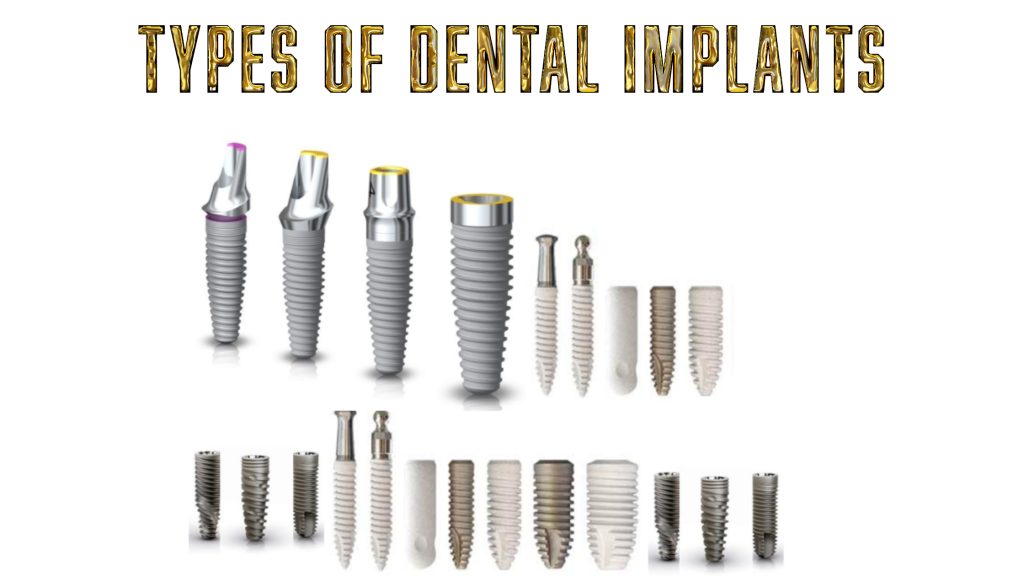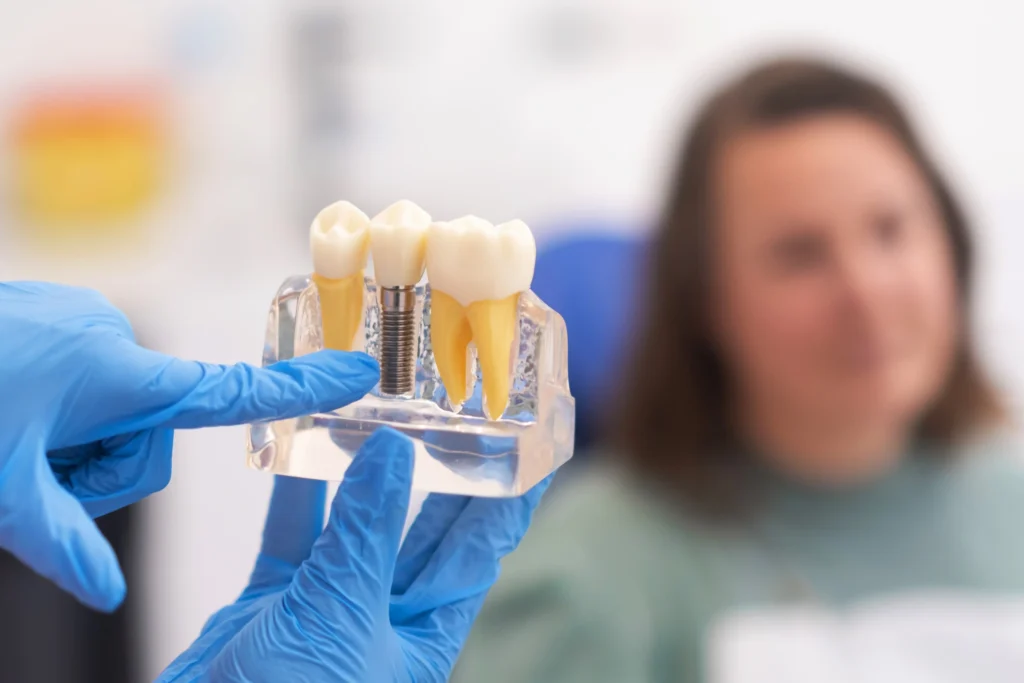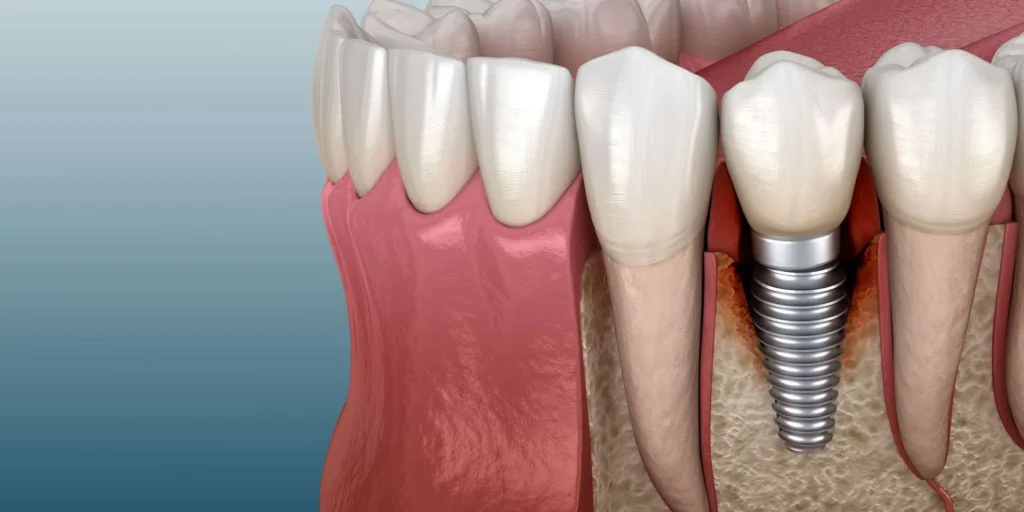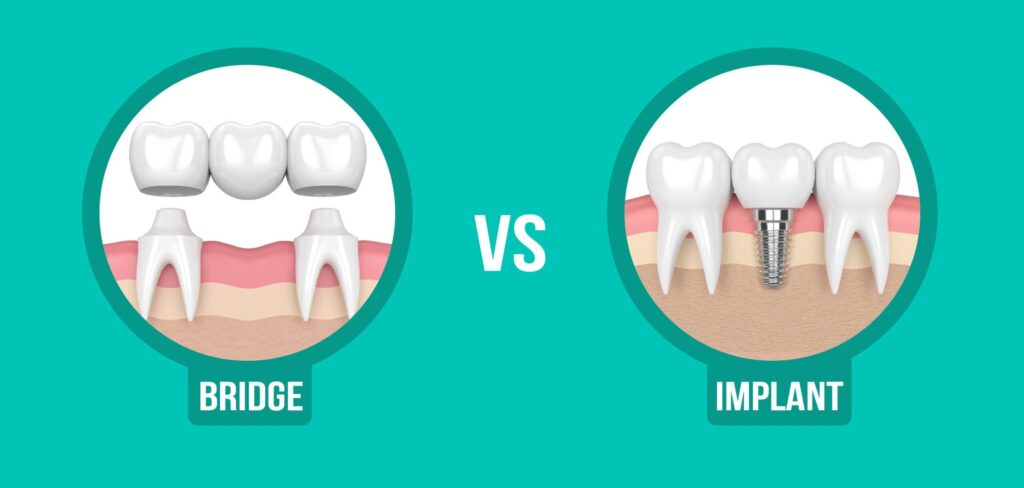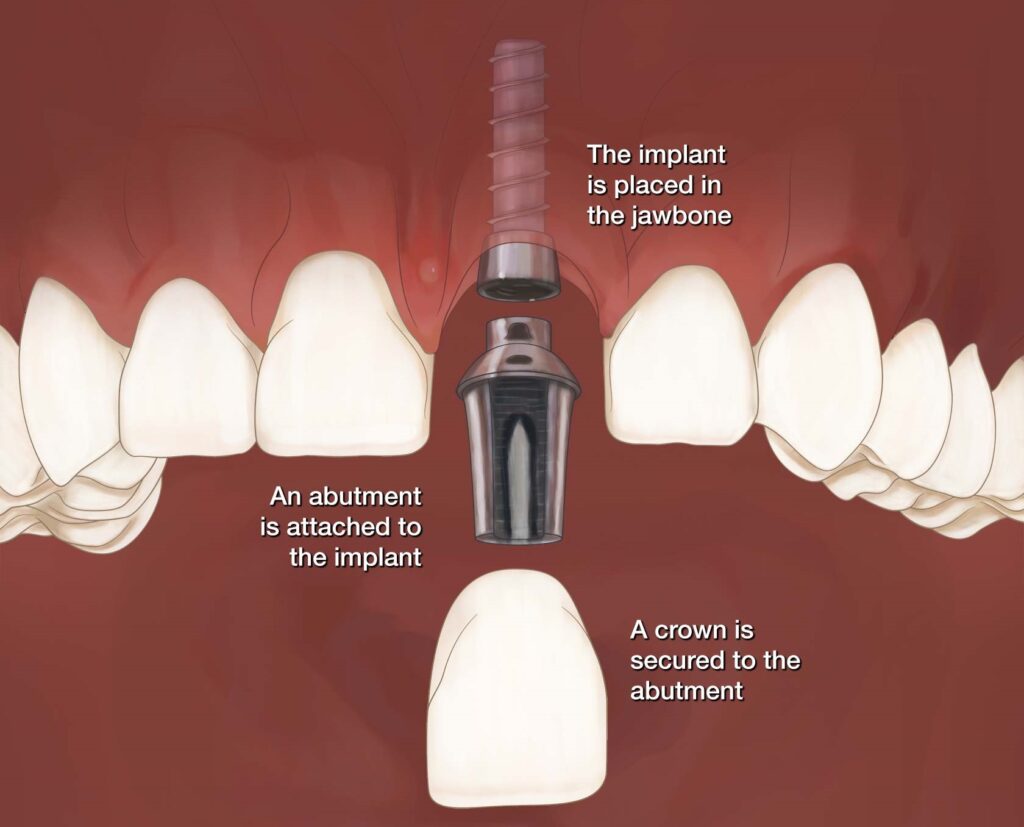
Front tooth dental implant requires more precision compared to back teeth because, in addition to functionality, aesthetics play a crucial role too. For this treatment to succeed, your dentist needs to pay attention to several key factors: First, your jawbone must have sufficient quality and volume – otherwise, a bone graft might be necessary. Second, the size and color of the implant should perfectly match your adjacent teeth for a natural appearance. Typically, all-ceramic or zirconia crowns are used since they closely resemble natural teeth and maintain a beautiful gum line.
A dental implant for a front tooth usually involves multiple stages: First, the implant post is placed in your jawbone and given several months to fuse with the bone (osseointegration). Then, a temporary crown is attached to help shape the gums naturally. Finally, your permanent crown, custom-designed to match your teeth’s exact color and shape, is secured. With proper care, these implants can last for years (even decades) while keeping your smile looking flawless. The most important thing? Always visit an experienced implant specialist who focuses on aesthetic dentistry for the best results.
In this blog, we’re going to explore more about front tooth implants, discuss their details, and help you determine whether this treatment option is right for you.
What Is a Front Tooth Implant?
A dental implant for a front tooth is a modern solution for replacing missing teeth in your smile zone. This system consists of three key parts: a titanium post that acts like a tooth root in your jawbone, a connecting abutment, and a ceramic crown designed to look exactly like a natural tooth. Unlike regular implants, front implants are chosen and placed with extra precision to create a completely natural appearance that blends seamlessly with your gumline and neighboring teeth.
At D’Amico Dental Care, our front tooth implants provide the most natural-looking and functional replacement available, while actively preventing jawbone deterioration. Unlike bridges that require altering healthy teeth, implants stand independently, preserving your dental anatomy. With proper home care and regular check-ups at our Watertown or Wayland locations, your implant can last 15-20+ years while maintaining your facial structure and a flawless smile.

Who Is a Good Candidate for a Front Tooth Implant?
The best candidates for replacing missing front teeth are people in good overall health with gums free from advanced disease. Having enough jawbone is crucial, though minor bone deficiencies can often be resolved with bone grafting. Non-smokers tend to achieve better outcomes, but smokers can improve their success rate by quitting at least two weeks before the procedure. A front tooth implant is typically most suitable for adults whose jaw growth is complete.
This treatment isn’t recommended for those with severe, untreatable bone loss or uncontrolled medical conditions like advanced diabetes. People who’ve had recent jaw radiation therapy or maintain poor oral hygiene also make poor candidates. Ultimately, your dentist will make the final determination through thorough examination and CT scan evaluation.
Benefits of Replacing a Front Tooth with an Implant
Replacing a missing Front tooth with a dental implant for front tooth offers unique advantages that set it apart from other options. Aesthetically, a front tooth implant creates a completely natural appearance, perfectly matching your existing teeth in color and shape. Functionally, it works just like a real tooth, allowing comfortable chewing and confident speaking without worries. Most importantly, it prevents jawbone loss and protects your healthy adjacent teeth from damage.
Beyond the physical advantages, this treatment restores your self-confidence and eliminates concerns about your smile’s appearance. Unlike removable dentures, dental implants are permanent and feel completely natural. With proper care, your implant can last 15-20 years or even longer, making it a valuable investment in both your oral health and beautiful smile.
Let’s explore some of these benefits in more detail.

Natural Look and Feel
A front tooth implant, thanks to its precise design and high-quality materials, creates an appearance nearly identical to natural teeth. The crowns made from zirconia or advanced ceramics mimic the light reflection and translucency of natural tooth enamel, blending perfectly with your adjacent teeth’s color. These characteristics are particularly crucial for the visible front area where aesthetics matter most. Moreover, through complete fusion with the jawbone (osseointegration), the implant provides natural sensation when chewing or speaking.
The natural feel of a front tooth dental implant impacts patients both physically and psychologically. Patients typically begin viewing their replacement tooth as part of their own body, significantly boosting their confidence. Unlike removable dentures that may cause discomfort or speech difficulties, the implant offers complete stability and functions like a real tooth. These qualities help patients forget they even have an artificial tooth, demonstrating this method’s remarkable success in achieving the most natural restoration possible.
Preservation of Jawbone Health
One of the most significant benefits of replacing missing front teeth is preventing jawbone deterioration. Unlike traditional methods like bridges or dentures that only replace the tooth crown, a front tooth implant mimics the natural root by transferring chewing forces to the bone. This mechanical stimulation maintains active bone remodeling and prevents progressive bone loss that typically occurs after tooth extraction. Studies show implants can preserve up to 95% of bone volume long-term.
“ Within the limits of a cross-sectional study, the results show that Morse-cone implants placed subcrestally in the vast majority of cases (89.9%) can maintain the bone crest at level of the rim or above it 1 year after loading. The incidence of loser sites (bone loss >0.5 mm) after at least 3 years of follow-up is 9.7% at implant level and 23.5% at patient level. “ onlinelibrary.wiley.com
Maintaining jawbone structure not only prevents facial deformation but also provides stable support for adjacent teeth. Bone loss can lead to neighboring teeth shifting, bite problems, and even facial feature changes. By preserving jawbone integrity, the front teeth implants prevent these complications while creating better conditions for potential future treatments. This benefit proves particularly crucial in the visible front area where facial aesthetics matter most.
Improved Speech and Chewing Ability
A front tooth implant plays a crucial role in restoring natural speech and chewing function. Unlike removable dentures that may cause lisping or altered pronunciation (especially for dental sounds like “s” and “z”), the implant provides complete stability, allowing your tongue to find its natural position during speech. For chewing ability, it restores 90-100% of natural tooth efficiency, enabling proper biting and effective food chewing, particularly important for front teeth that play a key role in the initial chewing phase.
Through complete fusion with the jawbone (osseointegration), the implant creates a sturdy foundation mimicking natural tooth roots. This secure connection prevents unwanted movement while speaking or eating. Additionally, the crown’s precise design ensures proper contact with opposing teeth, essential for effective chewing. Most patients report significant improvement in speech clarity and chewing comfort after full adaptation (typically 2-4 weeks), dramatically enhancing daily life quality.
Long-Term Durability and Stability
Front teeth implants boast an impressive 95-98% success rate in the first decade, making it one of the most durable tooth replacement options available. Unlike traditional bridges that typically need replacement every 7-10 years, high-quality implants with proper care can last 20+ years. This remarkable longevity comes from osseointegration – the process where the implant fuses with your jawbone to create a permanent, rock-solid foundation. Research shows front implants often outlast back ones since they endure less chewing pressure.
Your implant’s durability depends on several factors: jawbone quality, surgeon’s skill, implant type, and post-op care. Maintaining excellent oral hygiene with implant-specific brushes/floss, plus regular 6-month check-ups, significantly extends its lifespan. Avoiding harmful habits like smoking or chewing hard objects also prevents damage. These advantages make a front tooth dental implant a smart, long-term investment that becomes increasingly cost-effective over time.
Protection of Adjacent Teeth
One of the key advantages of replacing missing front teeth is protecting your healthy adjacent teeth. Unlike traditional bridges that require grinding down neighboring teeth, a dental implant for front tooth stands independently without affecting surrounding teeth. This preserves the natural enamel and structure of adjacent teeth while preventing unwanted shifting into the empty space that could cause bite problems.
By maintaining the neighboring teeth’s integrity, the front teeth implants reduce the risk of decay and periodontal issues. Other methods, like bridges, put extra stress on supporting teeth, potentially causing long-term damage. The implant evenly distributes chewing forces, preventing excessive pressure on adjacent teeth, especially important in the delicate front area, where it helps ensure lasting oral health.

Boost in Confidence and Self-Esteem
Replacing a missing front tooth with a dental implant for front tooth can dramatically boost a person’s self-confidence. Since front teeth play such an important role in facial appearance and smile, losing them often makes people reluctant to speak, laugh, or socialize freely. Front tooth dental implant, by providing a completely natural look, eliminates these concerns and allows people to engage socially without hesitation. Studies show over 80% of patients report significant improvements in their quality of life and self-confidence after receiving front tooth implants.
At D’Amico Dental Care, we understand that dental implants for front teeth do more than restore smiles—they renew confidence and transform lives. Our patients consistently report regaining their sense of self after treatment, with the freedom to eat, speak, and laugh without hesitation. This emotional restoration often leads to:
✔ Stronger social connections (no more hiding your smile)
✔ Improved professional confidence (speaking clearly in meetings)
✔ Reduced dental anxiety (finally loving your reflection)
✔ Greater enjoyment of life (eating all foods without worry)
More than just a tooth replacement, it’s a return to feeling like yourself again, which is why our Watertown and Wayland patients call it one of their best investments in themselves.
The Front Tooth Implant Procedure: Step-by-Step
The complete treatment typically takes 4 to 8 months and, according to 10-year studies, achieves a 95-98% success rate when following proper care, including antibiotics, pain medication, and chlorhexidine mouthwash.
Phase 1: Planning & Evaluation (1-2 visits)
- Clinical exam and CT scan imaging
- Digital smile design (DSD)
- Implant selection (typically 3-3.5mm diameter)
- Guided surgical planning
Phase 2: Implant Placement (1 visit, 60-90 minutes)
- Local anesthesia
- Precise gum incision preserving papilla
- Computer-guided drilling
- implant placement at 25-35Ncm torque
- Suturing and initial healing
Phase 3: Temporary Restoration (3-6 months)
- Temporary prosthesis for aesthetics
- Osseointegration waiting period
- Follow-up visits every 4-6 weeks
Phase 4: Final Restoration (2-3 visits)
- Cover screw removal
- Digital impression
- Final crown fabrication (zirconia/e.max)
- Occlusion adjustment and permanent placement
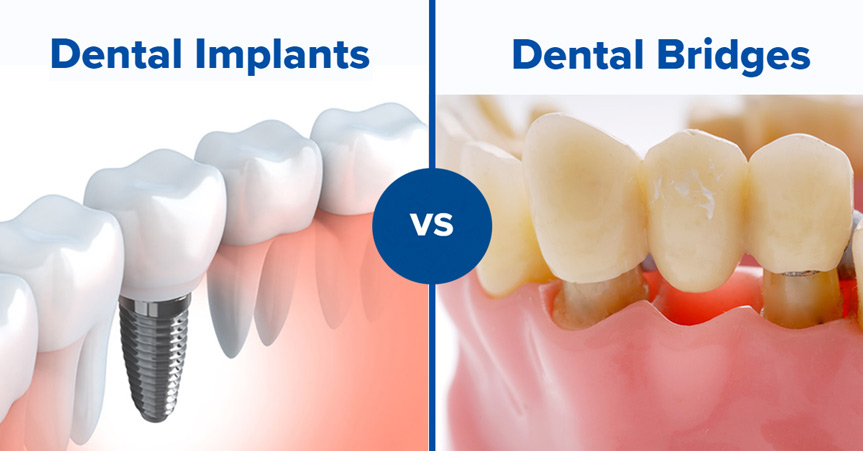
Front Tooth Implant vs Bridge: Which Is Better?
Implants are ideal for patients with sufficient bone and budget, while bridges may suit those with financial or medical limitations.
Advantages of Implants:
- Preserves adjacent teeth: No need to alter healthy neighboring teeth
- Prevents bone loss: Stimulates natural bone growth like real teeth
- Longer lifespan: 15-20 years vs. 7-10 years for bridges
- Lasting aesthetics: Better color/form stability
- Easy maintenance: Cleans like natural teeth
Advantages of Bridges:
- Lower cost: 30-40% cheaper than a front tooth implant
- Faster treatment: Completed in 2-3 weeks
- No surgery required: Better for medically compromised patients
- More feasible: Works with significant bone loss
Limitations of Each:
Implants: Higher cost, requires adequate bone, longer treatment
Bridges: Alter healthy teeth, decay risk under crowns, periodic replacements needed
Caring for Your Front Tooth Implant
Immediate Aftercare (First Week Post-Surgery):
• Use 0.12% chlorhexidine mouthwash twice daily
• Avoid brushing the surgical area with a regular toothbrush
• Stick to soft, cool foods and avoid chewing on your front teeth implants side
• Refrain from smoking and alcohol for at least 2 weeks
Long-Term Maintenance:
• Use an implant-specific soft-bristled toothbrush
• Clean daily with a superfloss or a water flosser
• Schedule professional cleanings/check-ups every 6 months
• Never bite hard objects with your front teeth
Key Reminders:
✓ Contact your dentist immediately if you notice looseness, pain, or swelling
✓ Regular check-ups are crucial for monitoring bone/gum health
✓ With proper care, your implant can last 20+ years
How Long Will a Front Tooth Implant Last?
A front tooth implant typically lasts 15 to 25 years with proper care, and often functions perfectly for a lifetime. Studies show a 95-97% success rate after 10 years. Its longevity depends on several key factors: jawbone quality, the surgeon’s skill, crown material (preferably zirconia or e.max), and consistent oral hygiene. For best results, professional cleanings and check-ups every 6 months are essential.
To ensure your implant lasts decades, follow these easy but essential care steps:
✔ Brush gently with a soft implant toothbrush
✔ Floss daily using superfloss or a water flosser
✔ Avoid smoking and chewing ice/hard foods
✔ Wear a night guard if you grind your teeth
✔ Visit us regularly for professional cleanings
At D’Amico Dental Care, we provide all our Watertown and Wayland implant patients with a free care kit and personalized instructions. With this simple routine, your implant can stay problem-free for 20+ years while keeping your smile looking and functioning perfectly.
Source: pubmed
FAQ
- What is the Process for Front Tooth Implant Placement?
- Initial Consultation: Examination and detailed planning (30-60 minutes)
- Preparation: CT scan and smile design (if needed)
- Surgery: Titanium fixture placement (45-90 minutes)
- Healing Period: 3-6 months for osseointegration
- Abutment Placement: Connecting the intermediary piece (20-30 minutes)
- Temporary Crown: For aesthetics during healing
- Final Crown: After complete osseointegration
- Why Are Implants the Best Choice for Front Teeth?
- Natural Appearance: Perfect color matching with adjacent teeth
- Jawbone Preservation: Prevents visible bone loss
- Complete Stability: No movement like dentures
- Natural Feel: Functions like real teeth
- Longevity: Can last a lifetime with proper care
- No Need to Alter Adjacent Teeth
- What Post-Operative Care is Required?
- First 24 Hours: Ice packs, avoid spitting, liquid diet
- First Week: Soft toothbrush, gentle saltwater rinses
- Restrictions: No smoking (2 weeks), intense exercise (1 week)
- Long-Term Care: Specialized brush, flossing, 6-month checkups
- Avoid: Biting hard objects with front teeth
- Will the Implant Look Completely Natural?
- Ceramic Crown: Matches natural tooth translucency
- Gum Design: Creates a natural gumline
- Perfect Harmony: Matches facial structure and adjacent teeth
- Light Reflection: Similar to natural enamel
- Precise Adjustments: Shape/color modifications until satisfaction
- How Long Does the Entire Process Take?
- Simple Cases: 3-4 months (with sufficient bone)
- Bone Graft Needed: 6-9 months
- Immediate Option: Temporary crown, same day
- Required Visits: Typically 3-5 main appointments
- Between Stages: Depends on healing progress
- What is the Cost and Insurance Coverage?
- Base Cost: 6-10 million Tomans per unit
- Cost Factors: Bone grafting, crown material, dentist expertise
- Insurance: Usually limited or no coverage
- Additional Costs: CT scan, bone graft, temporary crown
- Long-Term Savings: Avoids frequent replacements
- What Potential Complications Could Occur?
- Swelling/Bruising: Normal for 3-5 days
- Temporary Sensitivity: To hot/cold (2-4 weeks)
- Infection: If hygiene is neglected (<5% cases)
- Peri-implantitis: Gum inflammation around the implant
- Implant Failure: Rare (<3% for front teeth)
- How to Choose the Best Implant Dentist?
- Specialization: Implant surgeon/prosthodontist with anterior experience
- Portfolio: Review similar cases
- Technology: Digital equipment (CT scan, smile design)
- Warranty: Coverage for the implant and crown
- Consultation: Clear explanation of process/costs

